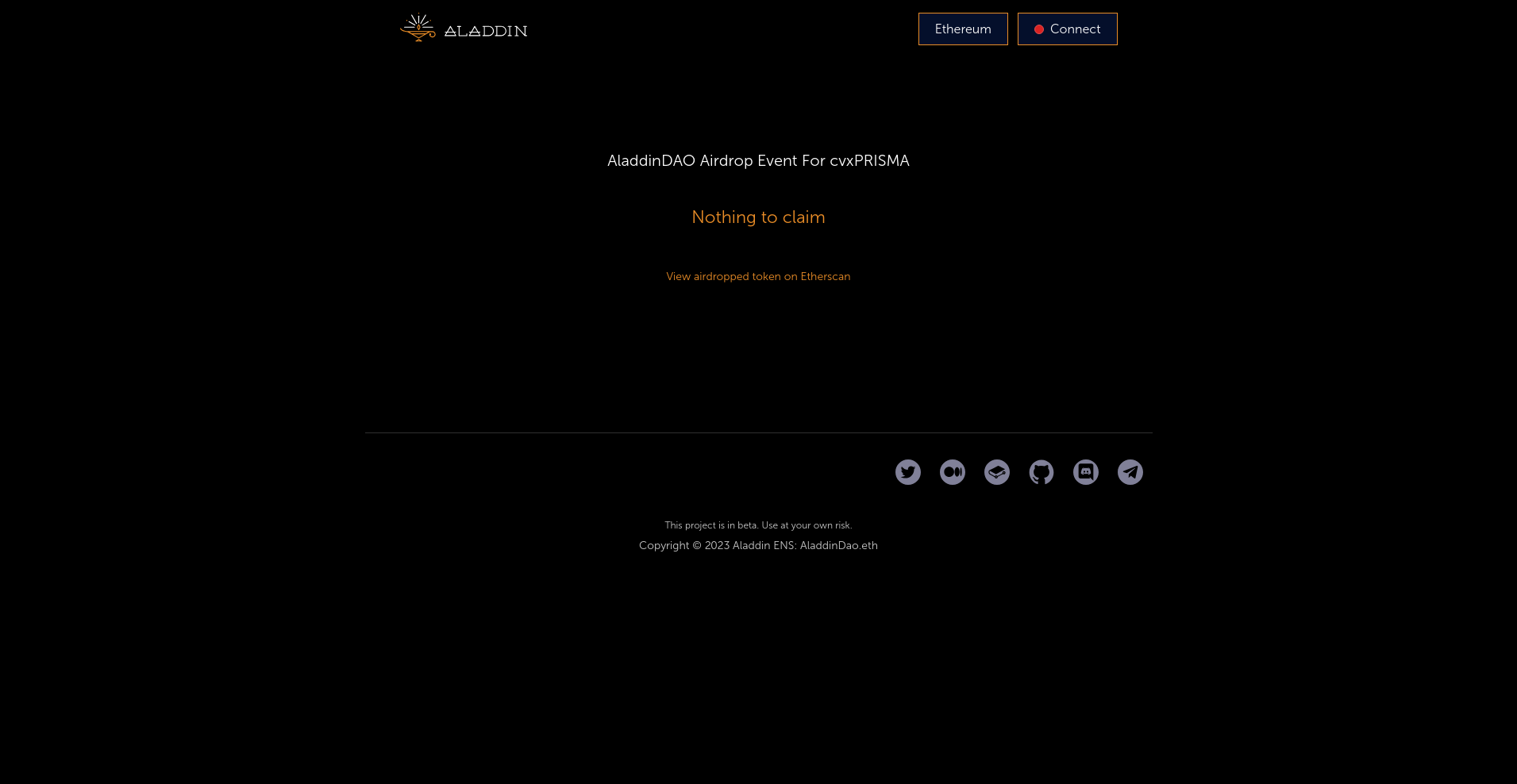Aladdin DAO ($ALD) Review: A Data-Driven Legitimacy and Risk Assessment

What Is Aladdin DAO: An Introduction
Aladdin DAO is a decentralized entity that positions itself as a builder and incubator within the DeFi space, focusing on innovative protocols such as its flagship Concentrator, CLever, and f(x) Protocol. Its mission revolves around creating scalable, secure, and high-yield DeFi primitives, leveraging community governance and a suite of audited smart contracts.
The platform emphasizes community involvement, security, and transparency, as evidenced by multiple audits from reputable firms. It supports various core functions—from yield optimization via vaults and harvesters to advanced leverage and stablecoin mechanisms. Importantly, it explicitly states that this project is in beta, advising users to exercise caution. For those interested in how such protocols can be combined, understanding DeFi protocol composability is key to appreciating the strategic depth.
The Team and Roadmap Evaluation
The publicly available information suggests a largely anonymous but technically experienced team, typical of many DeFi projects aiming to prioritize decentralization over individual prominence. This is common in the industry, but it warrants a closer look at their delivery capacity and transparency levels. For insights into why teams remain anonymous, consider exploring the risks of anonymous teams in DeFi projects.
Key milestones derived from the project’s audit reports and community proposals include:
- Multiple security audits (PeckShield, SecBit, Certik) covering core protocols like v2 contracts, Concentrator vaults, and CLever components.
- The deployment of several vaults and liquidity pools aligned with major DeFi ecosystems such as Curve and Convex.
- Active proposal systems (AIPs), indicating ongoing governance development, including proposals to expand protocol features, create forks, or optimize liquidity management.
- Community governance and risk meetings, with over two dozen signal requests and proposals, showcasing an engaged and evolving governance model.
While the roadmap’s granular details are limited, the active governance activities and multiple audits imply a team committed to iterative development and security. Still, the absence of detailed team backgrounds or public Developer/Management profiles is noteworthy from a trust perspective.
Assessing the Security and Integrity of Aladdin DAO
The analysis is based on the Cer.live audit report. The available audit coverage is comprehensive, with a 100% scope coverage across the platform's core contracts.
- Audit outcomes: Multiple audits from reputable firms like PeckShield, Certik, and SecBit endorse the security posture of critical modules like v2 contracts, Concentrator vaults, and CLever components. The reports, available through linked URLs, suggest thorough examination.
- Vulnerabilities: The audit data does not explicitly report unresolved critical vulnerabilities; however, the presence of ongoing bug bounty programs indicates a proactive approach to security.
- Security concerns: The platform relies on third-party infrastructure (LayerZero) for bridging, which introduces external risk. The platform explicitly states that it does not guarantee the reliability or security of LayerZero services, disclaiming liability for exploits.
- Insurance: There is no mention of insurance coverage for user funds, which increases the importance of strict security practices and audits.
In summary, while the project has undergone multiple external audits, the reliance on third-party bridging services and lack of insurance coverage warrant cautious engagement. The audits being publicly accessible and from top-tier firms are positive signs, but the beta status emphasizes ongoing risk. Users engaging with such platforms should be familiar with risk management strategies for beta-stage DeFi protocols.
A Breakdown of Aladdin DAO Tokenomics
The native token, $ALD, serves as a governance and utility token integral to staking and protocol participation. Based on available data:
- Total Supply: Approximately 150 million ALD tokens, with circulating supply around 149.83 million.
- Market Cap: Roughly $3.4 million, with moderate market activity indicated by a 2.4% recent increase.
- Distribution & Allocation: Specific allocations are not detailed, but community governance proposals and staking mechanisms suggest a significant portion is allocated for community incentives, rewards, and development.
- Vesting & Rewards: The platform offers staking options with rebasing rewards, and the mention of a “Vesting” section suggests some tokens are subject to lock-up schedules, possibly for team or strategic partners. Understanding rebasing tokens is crucial for comprehending how these rewards are distributed and affect token value.
- Utility: The token is used to participate in governance (via proposals), stake for yields, and possibly to activate certain protocol features.
Economically, the tokenomics appears standard but with risks typical of small-cap DeFi tokens—potential volatility, inflationary pressures, and dependency on continued governance participation. The lack of detailed vesting or emission schedules complicates a long-term sustainability assessment.
Assessing Aladdin DAO's Development and Ecosystem Activity
Data indicates active ecosystem development, particularly in the domains of vaults, liquidity pools, and governance proposals. The presence of multiple on-chain audits, ongoing proposals, and community discussions highlight a vibrant development process.
However, most metrics related to treasury size, TVL (Total Value Locked), and user engagement are currently at or near zero, which suggests the platform is either newly launched or in a pre-alpha state. The project’s focus on audits, governance, and layered protocols indicates a vision for composability and long-term ecosystem growth rather than immediate user adoption.
Additionally, continuous updates, audits, and governance proposals are signs of healthy iteration, but the low current TVL and on-chain activity imply that substantial real-world usage remains nascent.
Reviewing the Terms and Conditions
The platform explicitly states that it is in beta and users should proceed at their own risk. Notably, the platform disclaims liability for losses resulting from exploits or service disruptions, especially as it relies on third-party bridging services like LayerZero. There are no indications of proprietary insurance, and the legal language emphasizes the experimental nature of the platform.
Such clauses are common in beta-stage DeFi projects, but they highlight the importance of conservative engagement—users should limit exposure and avoid deploying significant funds until the protocol’s security and stability are more thoroughly established.
Final Analysis: The Investment Case for Aladdin DAO
Aladdin DAO presents itself as a multi-layered, community-driven DeFi project emphasizing security, governance, and protocol composability. Multiple third-party audits enhance its credibility, and its expanding proposal system signals active governance participation. However, the project's current state, with minimal on-chain activity and TVL, indicates it remains in early development phases.
Its reliance on external services like LayerZero introduces additional risk factors not directly controllable, especially given the policy disclaimers. The tokenomics are fairly typical but require caution due to the small market cap and early-stage metrics.
-
Pros / Strengths
- Multiple reputable external audits from firms like PeckShield and Certik
- Active governance proposals and community engagement
- Innovative protocol focus on leverage, stablecoins, and yield optimization
- Transparency in audit and security reports
- Supported by an ambitious multi-protocol ecosystem (Concentrator, CLever, f(x))
-
Cons / Risks
- Limited on-chain activity and low current TVL
- Reliance on third-party bridging infrastructure (LayerZero), with no guarantee guarantees or insurance
- Beta status with significant operational and security risks
- Potential for smart contract vulnerabilities despite audits
- Small market cap and limited liquidity, reflecting high volatility and risk
In conclusion, Aladdin DAO offers promising technological features and a transparent governance process, but its early-stage status and reliance on external infrastructure necessitate cautious engagement. Investors and users should monitor audit updates, community activity, and protocol development progress before allocating significant capital.

Jessica Taylor
NFT Market Data Scientist
Data scientist specializing in the NFT market. I analyze on-chain data to detect wash trading, bot activity, and other manipulations that are invisible to the naked eye.
Similar Projects
-
DRAGON ON TRON
DRAGON ON TRON ($DGTRON) Review: Risks and Legitimacy Explored
-
Chitaverse
Chitaverse Review: Is This Crypto Metaverse Project a Scam or Legit? | Crypto Scam Checker
-
BEEVO
Crypto Scam Checker Review: Is BEEVO a Legitimate Project or Scam?
-
zetta word
zetta word ($3-Z) Review: Security, Risks, and Community Insights
-
NoCap (NOCAP)
Review of NoCap (NOCAP): Is This Cryptocurrency Project a Scam or Legit? Crypto Scam Checker & Review